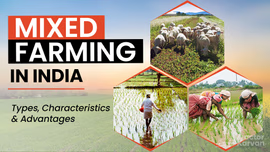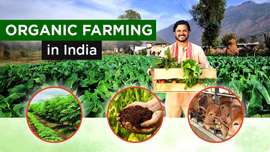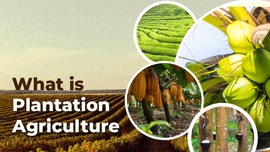The Blooming Journey of Geranium Plant: Cultivation, Varieties and Uses

Geranium is an herbaceous bushy perennial plant, popular in India. It has a strong aroma known for its strong rose-like odour. That’s why it is also called “Rose Geranium”. It is commercially grown for its essential oil. In today’s blog, we will deeply understand the complete cultivation process of geranium, along with its uses and varieties found in India. So, without any further delay, let’s dive into the blog.
Table of Contents
- What is a Geranium Plant?
- What are the Benefits/Uses of Geranium Oil?
- What are the Popular Varieties of Geranium Plants?
- How to Cultivate Geranium in India?
- Geranium Oil Distillation and Extraction Process
- Conclusion
What is a Geranium Plant?
Geranium is a perennial annual plant known for its sweet fragrance and bright-coloured flower. The scientific name of geranium is “Pelargonium graveolens”, and it belongs to the “Geraniaceae” family. The stem is cylindrical, woody at the base, green when young and turning brown with age. Its oil is popular all over the world. The pure geranium oil is almost a perfume by itself and blends well with other perfumes. It is a native plant from South Africa and is widely cultivated in India in the states of Uttar Pradesh, Punjab, Haryana, Bihar, Himachal Pradesh and North-Eastern regions. It is also cultivated in districts like Sambhal, Budaun, and Kasganj of Uttar Pradesh, using the new method developed by CSIR-CIMAP. Now you have an overview of geranium, so if you want to grow it, then keep on reading the blog about the benefits, varieties and complete cultivation process.
What are the Benefits/Uses of Geranium Oil?
Geranium is renowned for its essential oil, prized for its intense rose-like fragrance, with geraniol and citronellol being its primary constituents. Below are the uses and benefits of using geranium oil:
- Geranium oil is a good astringent that reduces wrinkles and treats acne, eczema, dermatitis, inflammation, and other skin issues.
- It has a very pleasant aroma, just like a rose, so it is also used in making aromatherapy, cosmetics, perfumes, and scented soaps.
- Geranium oil reduces the problem of Alzheimer’s, nervous pathology, and disorders.
- Additionally, it is beneficial for hair.
- Its anti-inflammatory properties help in healing wounds.
- Its dried flowers and leaves are also used in cooking, decorating, potpourri, etc.
What are the Popular Varieties of Geranium Plants?
Geranium flowers typically come in a lot of colours, including pink, red, white, and purple. These are plants are available in different varieties such as:
- Algerian or Tunisian
- Egyptian
- Reunion or Bourbon
- Hemanthi
- Bipuli
- IIHR-8
- Kodaikanal 1
How to Cultivate Geranium in India?
Soil requirements, land preparation, propagation, planting, irrigation, etc. are some steps of the geranium plant cultivation. Let’s understand the complete geranium cultivation process below:
Soil and Climate Requirements
Being a shallow-rooted crop, Geranium grows well in well-drained porous soil. The soil should be rich in organic matter. It requires a pH of 5.5 to 6.0. It can be grown in tropical, sub-tropical, and temperate climates with an elevation ranging from 1000 - 2400 m. An annual rainfall of 100 to 150 cm, evenly distributed throughout the year, and a temperature ranging from 5°C to 23°C is ideal. However, temperatures below 3°C will destroy the plant. Saline and alkaline soils are not suitable for geranium cultivation.
Land Preparation
Geranium is a long-standing crop, so ploughing twice or thrice is important, and after that, the soil should be fined with the help of a rotavator. Complete the process by levelling the soil properly. As this is long-term cultivation, the plant should be prepared properly so that it won’t be damaged.
Propagation
Geranium has no seed setting, so it is propagated vegetatively by cuttings. To propagate geranium, terminal cuttings of 20 cm in length consisting of about 8 nodes are taken from healthy plants. All the leaves are trimmed except for the first 3-4 leaves from the top. After trimming, the cuttings are treated with a 0.1% Benlate solution for 10 to 20 seconds.
Planting
After its propagation, geranium is planted in nursery beds at 5 cm spacing. The best time for planting geraniums is from April-May. The plants are watered twice daily for about 3-4 days and once a day. The nursery is sprayed with a 0.2% Urea solution at bi-weekly intervals, and the cuttings are ready for transplanting 2 months after planting. For transplanting, the rooted cuttings are dipped in 0.1% Benlate solution and transplanted immediately at 60 x 60 cm spacing.
Irrigation
Irrigation depends upon the soil type and climate of the region. However, Geranium requires very little water to grow, so proper irrigation is very important; otherwise, the crop may be damaged by water logging. Irrigation should be done on alternate days for first 15 days and then reduced to twice a week. Frequent irrigations are needed during the winter and summer months at intervals of 7 to 10 days, depending on the situation.
Fertilization
Ten tons of good quality FYM, 35 kg N, 35 kg P2O5 and 35 kg K2O/ha are incorporated into the soil in the form of urea, superphosphate and muriate of potash. A second dose of nitrogen at 35 kg/ha is applied about 2 months after the first application. Further, nitrogen is given in two equal split doses for each harvest, the first dose being just after the crop is harvested and the second two months later.
Pruning
Extensive pruning is not required in geranium. However, the wilted flowers should be removed to encourage new growth during the blooming season. Pinching the growing tips of young geraniums can also help shape their growth.
Pest and Disease Management
Geranium is not prone to severe pests and diseases. The common pests are termites and the wilt disease, caused by the Fusarium species, and Botrydeplodia theobromine, which are soil-borne fungi, are common.
To protect the geranium plant from pests and diseases, follow the following methods:
- Spray the crop with 0.2% Benlate solution two weeks before the harvest. After the harvest, treat the cut ends with fungicide and repeat the spray after two weeks.
- Termites can be easily controlled by mixing 25 kg Heptachlor per hectare into the soil and irrigating the area.
Harvesting and Yield
Geranium is harvested after 4 months of transplanting. When the leaves start changing colour, turning light green, and exhibit a change in odour from lemon to rose, it is the right time to harvest them. It should be done using a sharp sickle and taken for distillation immediately. As this is a perennial crop, it can give good harvests for about 3-6 years. A total of three harvests in a year can be obtained. Of all three harvests, it yields about 15 tonnes per hectare yield, which on distillation may yield about 18 kg of oil.
Geranium Oil Distillation and Extraction Process
The fresh harvests are used for the distillation of oil. The essential oil is distributed on the green parts, usually the leaves of the plant. It is stacked near the stills for about 12 to 24 hours for a slight fermentation and splitting of the glycosides, which increases the yield of oil.
The oil is extracted by a simple steam distillation method. It is packed and steamed in a separate boiler. The steam carries the oil, and the oil volatilizes and escapes along with the steam vapours, which is later condensed with running cold water. Finally, it is separated from the water and filtered with active carbon to obtain pure oil extract.
Conclusion
Now, we have come to the end of this blog, so let’s just quickly sum up all the points. We have discovered that geranium is a very useful plant with many benefits and uses. Its demand in the Indian market is increasing, so adopting the correct cultivation practices can lead to increasing farmers' income and the cosmetics and fragrance market scope in the country. So, what are you waiting for? Start your geranium farming journey now!


Related Blogs












